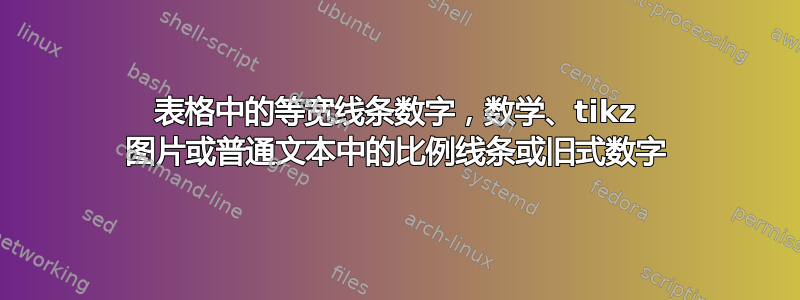
我正在尝试设置一个文本,其中在表格(等)monospaced lining中使用图形、图片和环境中的图形以及整个普通文本中的图形。tabularslongtableproportional liningtikzmathproportional oldstyle
之前也曾有人问过类似的问题这个问题。
然而,我对这些答案并不满意,因为它们对我来说并不完美。这就是为什么我想再次就我观察到的具体问题提出这个问题。
目前,我在标题中使用以下代码:
\usepackage[cmintegrals, cmbraces, libertine]{newtxmath}
\makeatletter
\AtBeginDocument{\libertineOsF}
\makeatother
这或多或少完成了任务。但是,请注意11句子末尾的。两个数字之间的字距太大了。看起来可能不多,但我觉得这很烦人。
这是另一个例子,看起来11正确,但是我在表格中没有monospaced数字(即,表格中的数字不再对齐):
我尝试了上面帖子中提出的所有解决方案。然而,没有什么帮助。
更新:
解决方案应确保table of content不受更改的影响。Piet van Oostrum 提出的当前解决方案既更改了章节/节号,也更改了页码(最初章节/节号是monospaced oldstyle图片,而页码是monospaced lining图片)。
以下是 MWE:
例一:
\documentclass[a4paper,
11pt]{scrbook}
\usepackage{libertine}
\usepackage{siunitx}
\sisetup{
group-digits=true,
group-minimum-digits=4,
add-integer-zero=false,
detect-all = true,
mode=math
}
\usepackage[british]{babel}
\usepackage[cmintegrals, cmbraces, libertine]{newtxmath}
\makeatletter
\AtBeginDocument{\libertineOsF}
\makeatother
\begin{document}
\begin{center}
\begin{tabular}{S[table-format=4.0] S[table-format=0.2]}
\hline
{Big number} & {Small number} \\ \hline
1711 & .22 \\
3333 & .11 \\ \hline
\end{tabular}
\end{center}
This is just some meaningless text where I want to show you, what is going on (see Figure~3; $p < .33$). Really, this text does not mean anything. Nevertheless, it is useful and contains probably more than 55 letters. Here you see the annoying fact with some of the figures: 11.
\end{document}
示例 b:
\documentclass[a4paper,
11pt]{scrbook}
\usepackage{libertine}
\usepackage{siunitx}
\sisetup{
group-digits=true,
group-minimum-digits=4,
add-integer-zero=false,
detect-all = true,
mode=math
}
\usepackage[british]{babel}
\usepackage[cmintegrals, cmbraces, libertine]{newtxmath}
\makeatletter
\AtBeginDocument{\def\libertine@figurealign{}\libertineOsF}
\makeatother
\begin{document}
\begin{center}
\begin{tabular}{S[table-format=4.0] S[table-format=0.2]}
\hline
{Big number} & {Small number} \\ \hline
1711 & .22 \\
3333 & .11 \\ \hline
\end{tabular}
\end{center}
This is just some meaningless text where I want to show you, what is going on (see Figure 3; $p < .33$). Really, this text does not mean anything. Nevertheless, it is useful and contains probably more than 55 letters. Here you see the annoying fact with some of the figures: 11.
\end{document}
这可能也是一个好问题元:如何提出已经提出但尚未完全回答的问题,尽管它被标记为“已回答”?
答案1
您引用的解决方案如下:
\makeatletter
\AtBeginDocument{\def\libertine@figurealign{}\libertineOsF}
\newcommand\libertineTabular{\def\libertine@figurealign{T}\libertineLF}
\makeatother
然后它在环境\libertineTabular之前使用tabular。这也适用于你的情况。
\begin{center}\libertineTabular
\begin{tabular}{S[table-format=4.0] S[table-format=0.2]}
您还可以使用该etoolbox包使其自动化:
\documentclass[a4paper, 11pt]{scrbook}
\usepackage{libertine}
\usepackage{siunitx}
\sisetup{
group-digits=true,
group-minimum-digits=4,
add-integer-zero=false,
detect-all = true,
mode=math
}
\usepackage[british]{babel}
\usepackage[cmintegrals, cmbraces, libertine]{newtxmath}
\makeatletter
\AtBeginDocument{\def\libertine@figurealign{}\libertineOsF}
\newcommand\libertineTabular{\def\libertine@figurealign{T}\libertineLF}
\makeatother
\usepackage{etoolbox}
\AtBeginEnvironment{tabular}{\libertineTabular}
\begin{document}
\begin{center}
\begin{tabular}{S[table-format=4.0] S[table-format=0.2]}
\hline
{Big number} & {Small number} \\ \hline
1711 & .22 \\
3333 & .11 \\ \hline
\end{tabular}
\end{center}
This is just some meaningless text where I want to show you, what is going on (see Figure~3; $p < .33$). Really, this text does not mean anything. Nevertheless, it is useful and contains probably more than 55 letters. Here you see the annoying fact with some of the figures: 11.
\end{document}





